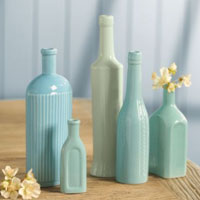DIGGING in my backyard one day, my shovel connected with something that made a glassy clink. This didn’t surprise me too much, since there were quite a few bits of broken glass a few inches below the surface; but further excavations revealed not a piece of broken jam jar or beer bottle as I had expected, but something far more interesting.
What I extracted from the ground was one of those two-toned Dutch bottles which you have seen being used as a flambeau, or appearing these days in souvenir shops. Examining it, I saw that it had a hairline crack running from the neck to the base, but was in otherwise good condition.
 |
 |
 |
 |
 |
 |
 |
 |
 |
 |
 |
There was no question of what to do with it, my mother’s sister residing in Pennsylvania loved antiques, and this would be right up her alley. It was placed in a corner to await her arrival later that year, and soon forgotten about.
“Joan would want this,” said my mom, stumbling on the bottle some months later. “Yeah, it’s for her,” I said. The next time I saw the bottle it was in a prominent place in the house, holding a white lily picked from the front of the yard, and I was struck by the simple and beautiful arrangement. From then on, every glass and ceramic bottle became a potential collectible or centerpiece.
The great thing about bottles is that they are as perennial as the grass. Various industries use bottles and jars to package their products. “Why would anyone find anything interesting about their Dill pickle jar?” you may ask. This is where your imagination becomes the only limit.
A cluster of these jars can be painted from the inside, creating a pretty ceramic-looking appearance from the outside. These can then be used to store pens, markers and other things. Perfume companies often package their products in bottles with unique designs, so that consumers associate the bottle’s shape with a particular scent,and some of them are quite beautiful.
Bottles are as old as the history of humanity. The earliest containers for liquids were dried gourds and animal skins, but clay bottles appeared thousands of years ago. Ancient Greeks and Romans used large earthenware jars and vases called amphorae to store and transport liquids.
By 1500 BC, Egyptians became the first to make glass bottles for storing cosmetics, ointments, and perfumes. By 200 BC, they had become efficient manufacturers of glass, along with the Chinese. The mold and glassblowing techniques spread to Europe during the 15th and 16th centuries. The first bottle and glassmaking factory began operating in Virginia in 1608.
In 1903, Michael J. Owens of Toledo, Ohio invented an automatic system for making different types of bottles, and this is much the same today.
So here is how to get started. Use empty wine bottles, or spray paint rum bottles and use them as garden edging tools. As wine bottles have a strong base, they can be used as long as you want.
Simply cutting off the upper part is another brilliant way of putting your empty wine bottles to good use. Convert them into decorative cups by cutting the tops with a glass cutter, and use them to place candles or simply a set of dry flowers.
Cover tops of jars with cupcake liners for a fun and festive idea. Use jars in the kitchen for the vintage pantry feel, and show off your foods in attractive ways. Fill them, paint them, group them, and have a great time using these common everyday items in new and interesting ways!



.jpg)








